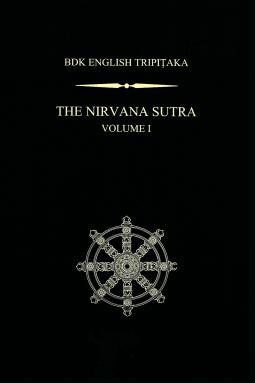(Created page with "{{Book |BookParentPage=Secondary Sources |FullTextRead=No |TextTranslated=Texts/Mahāparinirvāṇasūtra |BookToc=* {{i|A Message on the Publication of the English Tripiṭak...") |
No edit summary |
||
| (6 intermediate revisions by the same user not shown) | |||
| Line 1: | Line 1: | ||
{{Book | {{Book | ||
| | |BookPerson={{Book-person | ||
|PersonPage=Blum, M. | |||
|PersonName=Mark Blum | |||
}} | |||
|FullTextRead=No | |FullTextRead=No | ||
|TextTranslated=Texts/Mahāparinirvāṇasūtra | |TextTranslated=Texts/Mahāparinirvāṇasūtra | ||
|BookToc=* {{i|A Message on the Publication of the English Tripiṭaka | |BookToc=* {{i|A Message on the Publication of the English Tripiṭaka, ''NUMATA Yehan''|v}} | ||
* {{i|Editorial Foreword | * {{i|Editorial Foreword, ''MAYEDA Sengaku''|vii}} | ||
* {{i|Publisher’s Foreword A. | * {{i|Publisher’s Foreword, ''A. Charles Muller''|ix}} | ||
* {{i|Translator’s Introduction | * {{i|Translator’s Introduction, ''Mark L. Blum''|xiii}} | ||
* {{i|The Nirvana Sutra, Volume I|}} | * {{i|The Nirvana Sutra, Volume I|}} | ||
* {{i|Fascicle I|}} | * {{i|Fascicle I|}} | ||
** {{i|Chapter One. Longevity: Part 1|3}} | ** {{i|Chapter One. Longevity: Part 1|3}} | ||
* {{i|Fascicle II|}} | |||
** {{i|Chapter One. Longevity: Part 2|31}} | |||
* {{i|Fascicle III|}} | |||
** {{i|Chapter One. Longevity: Part 3|69}} | |||
** {{i|Chapter Two. The Adamantine Body|91}} | |||
** {{i|Chapter Three. The Virtues of the Name|103}} | |||
* {{i|Fascicle IV|}} | |||
** {{i|Chapter Four. The Nature of the Tathāgata: Part 1|107}} | |||
* {{i|Fascicle V|}} | |||
** {{i|Chapter Four. The Nature of the Tathāgata: Part 2|135}} | |||
* {{i|Fascicle VI|}} | |||
** {{i|Chapter Four. The Nature of the Tathāgata: Part 3|169}} | |||
* {{i|Fascicle VII|}} | |||
** {{i|Chapter Four. The Nature of the Tathāgata: Part 4|201}} | |||
*** {{i|[The Four Inversions]|224}} | |||
*** {{i|[The Five Parables on Buddha-nature]|226}} | |||
* {{i|Fascicle VIII|}} | |||
** {{i|Chapter Four. The Nature of the Tathāgata: Part 5|235}} | |||
*** {{i|[The Garland of Letters]|253}} | |||
* {{i|Fascicle IX|}} | |||
** {{i|Chapter Four. The Nature of the Tathāgata: Part 6|271}} | |||
* {{i|Fascicle X|}} | |||
** {{i|Chapter Four. The Nature of the Tathāgata: Part 7|305}} | |||
** {{i|Chapter Five. The Query of the Entire Assembly|313}} | |||
* {{i|Notes|339}} | |||
* {{i|Glossary|365}} | |||
* {{i|Bibliography|375}} | |||
* {{i|Index|383}} | |||
* {{i|A List of the Volumes of the BDK English Tripiṭaka (First Series)|425}} | |||
|PostStatus=Needs Copy Editing | |||
|ExtraCategories=BDK America | |||
|StopPersonRedirects=No | |||
|AddRelatedTab=No | |AddRelatedTab=No | ||
|BookParentPage=Secondary Sources | |||
}} | }} | ||
Latest revision as of 13:56, 28 July 2023
Taishō 374
Volume 12
The Nirvana Sutra deals with the teachings given by Śākyamuni shortly before his death (mahāparinirvāṇa). Nirvāṇa means "extinguishing the flames of passion and attaining the state of enlightenment." Since Śākyamuni attained enlightenment at the age of 35, he did in fact already enter nirvāṇa at this time. But because it was considered impossible to completely extinguish the passions while retaining a physical body, Śākyamuni’s death came to be called mahāparinirvāṇa, i.e. "the state of great serenity in which the flames of passion have been completely extinguished." The sūtra gives the teachings expounded by Śākyamuni immediately before his death. As it contains episodes relating to events before and after his death, it also has value as historical source material.
Source
Skt. Mahāyāna Mahāparinirvāṇa-sūtra, translated into the Chinese by Dharmakṣema as Da banniepan jing (大般涅槃經). 40 fascicles. (Source: BDK America)
| Citation | Blum, Mark L., trans. The Nirvana Sutra (Mahāparinirvāṇa-Sūtra). Vol. 1. BDK English Tripiṭaka Series. Moraga, CA: BDK America, 2015. https://bdkamerica.org/product/the-nirvana-sutra-vol-i/. |
|---|---|

